Beakuency welcomes Marian Sole, one of the field trip coordinators for the Alan Devoe Bird Club in Columbia County. Her exceptional community-building skills are a great driving force in fostering a sense of connection for bird lovers in the county and beyond, and creating a supportive space for all who are interested in birding. Making meaningful bonds with others in real life is more important than ever in this social media age we live in. Marian shares how birds make it so easy for us to connect with each other regardless of our differences, how you can support the citizen science projects happening in our area, and what actions you can take right in your own backyard to help local birds.
This interview was recorded on January 22nd 2025, and broadcasted on January 25th 2025 on Wave Farm’s WGXC 90.7 FM.
Interview Transcript
Mayuko Fujino: Could you briefly introduce yourself?
Marian Sole: Yes. I'm Marian Sole. I live in Ancram in southeastern part of Columbia County.
MF: You are one of the field trip coordinators for the Alan Devoe Bird Club, and you also coordinate community science projects such as eagle count, which just happened. What do you enjoy about this role of coordinator and what are the challenges?
MS: Coordination is not as interesting to me as the fact that these are all kind of citizen science projects that you're doing, or that you're actually contributing data and collecting it for, whether it's for Cornell's eBird, or all the different projects that happen throughout the year. There are probably about, oh, I don't know, there must be six to eight different citizen science projects that happen through the year. You have the eagle count, you have the DEC doing raptor surveys over winter. You have the waterfowl count. You have the breeding bird survey in June, that's done, I think, by DEC, where you travel about 25 miles, stopping every half mile for resident birds. You've got the Thatcher Hawk watch in September, and then you have the Christmas counts in December.
So there's a lot of opportunities. Well, also there's Project Feeder[Watch], a backyard project thing that Cornell does. So there's a lot of opportunities where you can do citizen science. But actually getting to have those and getting to have enough people that are interested in doing all these different projects, I think is where the coordination of the field trips arise.
You really want to have as many people as possible helping you on these, because if I go out by myself and go down the river and look for eagles, I may find probably maybe 60% of the Eagles there. But if I've got multiple eyes looking, we're going to have a lot more people, we'll find a lot more eagles, we'll find a lot more or we hear more birds. If we're going on a bird walk, there's a sort of a limit to how many people you want in the bird walk. But you do want probably about 10 to 12 people, because that's enough pairs of eyes that you're going to find things that you wouldn't otherwise find. So I enjoy doing that.
When I retired, I felt like, what do I want to do with my life? And I think citizen science projects are connected to things that I really like doing, like being outside and birding, that seemed natural.
MF: So when you coordinate these things, it really means that you try to get people to participate. And do you decide on dates?
MS: You want to figure out what you might be seeing. So right now, for example, coming up in March, maybe we'll start to see some more of the ducks coming through. Right now there are a few ducks because the ponds are frozen and the river's now frozen, so there's nowhere for the ducks to go. So as the water thaws, we'll start seeing ducks migrating north, coming through. And then we'll start to see shorebirds coming through in March, April, and then we'll start to see warblers coming through in April and May into June, and then we'll get the ones who are actually breeding that we get to see.
So every month there's something different, a different type of species that you're really looking for. So when we're trying to do the walks, we want to do walks where we can get to see a number of birds, a number of species, but we also want to have birds that are going to be attractive to non birders. Eagles are attractive to anybody. Whether you're a birder or a non birder, it's exciting to see an eagle. So we can usually get people come who wouldn't normally come to that. Generally speaking, it's very hard, I think, if you're not a birder to necessarily go on a warbler walk. They're so much smaller, they move so fast. They're very hard to get people on them.
What we found is if we do walks at same places with same organizations year after year, you tend to get some of the same people coming out and they get better at finding things. So we've done a lot of walks at Clermont Historic Park. We tend to have some of the same birders come out each year. They don't come to other walks, but they come to that one because they're friends of Clermont and they like doing it there. And over time, they've really got better. They've learned how to hold binoculars, they've learned how to find the bird through the binoculars, which not everybody can do starting out. They don't know how to set their binoculars up.
And I think that sort of things we can do is to help make it easier for people who are maybe beginning to think about looking at birds. Maybe they've got bird feeders and they're trying to see them, but they really don't know what they're looking for or what they're looking at or how to find the birds.
When I was first starting to bird in Connecticut, I would bird with somebody who'd lead bird walks and he would never tell us about birdsong. And so I thought he was just a magician that he could find these warblers and know before, almost before he put his eyes on them, what they were. But it's because he knew the birdsong. And it wasn't till I came here up to the upstate New York and people like Larry Federman really taught me about how to find birds that you realize there's so many different things you need to know to really have a fun time out there. So I think a lot of these trips are really ways of educating people about birds, but also how to make it more enjoyable. So they might remember the bird, something they saw the bird doing, or they might remember something that will help them recognize that bird again when they see it.
MF: So these community science projects are not just for people to contribute to science, but for them, it's a great opportunity to learn.
MS: Yeah. And it spreads the message to a lot of other people about bird conservation and the need for it and why, and how many we're losing.
MF: While improving their own skills of finding things and listening.
Do they tell you where to go? Well, Christmas bird count, they (National Audubon Society) give you the range…
MS: With Christmas bird count, you just have a sector that you have to do. But our regular walks [for the public], and we're trying to set them up — I set them up with Chris Franks (ADBC's other field trip coordinator) the weekend walks — or when I set up with the Tuesday walks [for ADBC members], I'm trying to make sure that we cover the whole county.
I'm trying to think about what birds might we see in that month and therefore what would be a good place to go. So, for example, when we partner with the New York Ornithology Association Young Birders [Club], which is a great group, these are incredibly exciting kids who are unbelievable in their knowledge of birds. And they're usually ranging from about age 10 to about 16. When they're going to come join us, we have to think about, okay, if they come in May, they're really going to want to see warblers. Where in our county do we have good warblers? And we know that we find, you know, we've got records that show warblers are really good at Overmountain, at Drowned Lands, up at Hand Hollow. There are a number of different places we could take them. I wouldn't go walking there necessarily in January, but because I'm looking at warblers in May, and that's where I'm going to find them. That's how we'll arrange where we go.
MF: So, for example, Eagle Count, that's organized by the Army Corps of Engineers…
MS: They haven't always done it. They took it over, I think, about 10, 15 years ago.
MF: From whom?
MS: I think it started off with the National Wildlife Federation, then somebody else took it over, and then somehow the Army Corps of Engineers ended up with it.
MF: I see.
MS: I don't understand that at all. But anyway, they've been running it for the last 10, 15 years, and there's a sort of a route that's always been done.
MF: Oh, okay.
MS: And they haven't always. So that's why we start at Stuyvesant Landing and we stop at almost every public place along the river until you get down to Clermont when you do the eagle count. They're only now really trying to get their routes in place, but it's a route that's been done a long time. It's a site that they has a number to it, and they've assigned a record to it so they can see what was done in prior years.
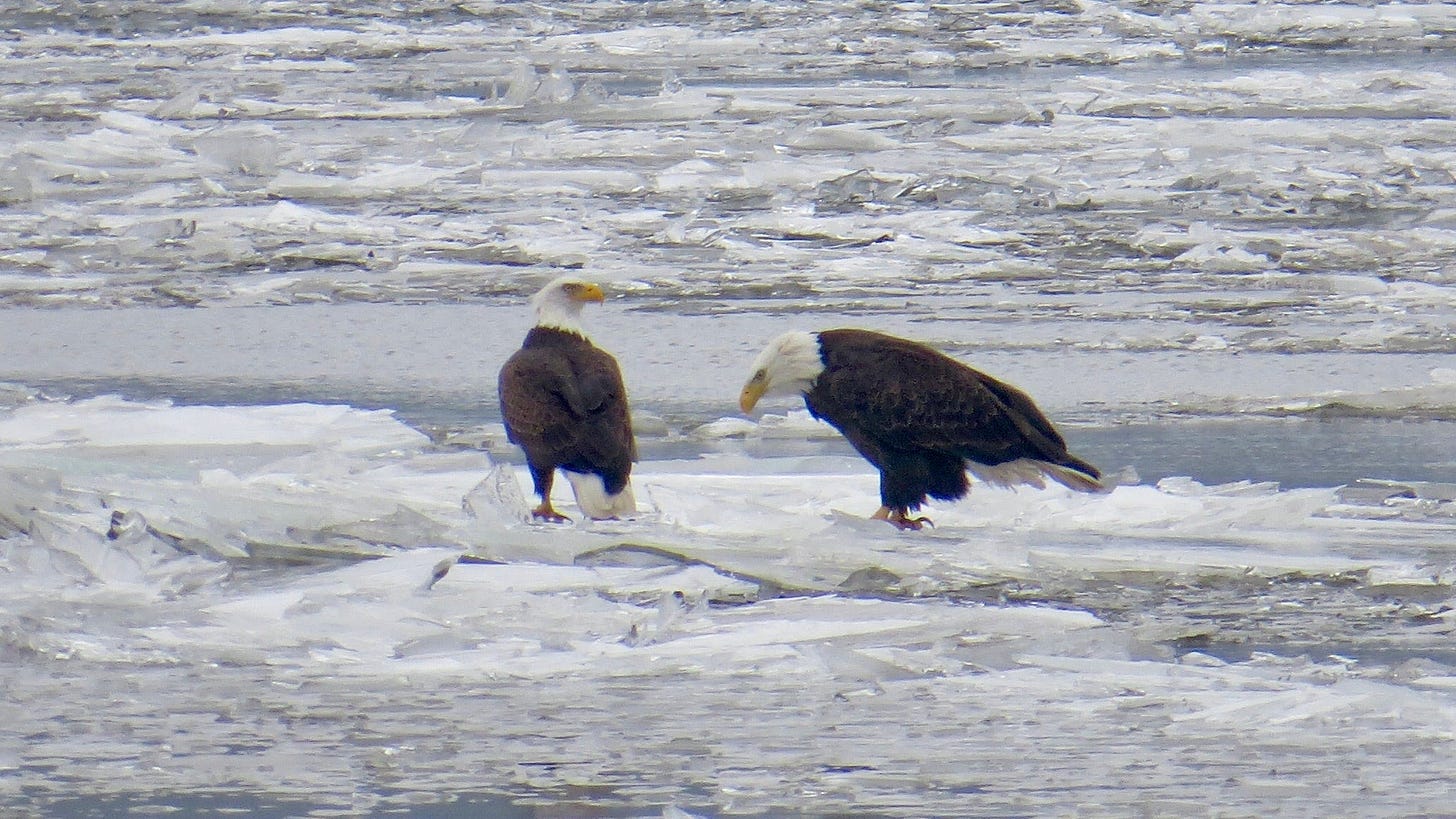
MF: So these stops that we make at Eagle Count, it's not so much that they, Army Corps of Engineers, tell you specific spots, but they say, from here to here by the Hudson river. And local birders decide which spots would be best to do that.
MS: And if we wanted, for example, if we thought, oh, well, it really could be interesting to do an eagle count somewhere else in the county, we could propose that we do that, and they would be interested.
MF: I see.
MS: There are people doing these eagle counts up in Alaska. They have them doing it by, oh, I don’t know, hella teleskiing, whatever you call it. You know, they drop people off and off they go and they look for eagles. They have people who are kayaking to find them. I mean, there's all sorts of different ways that people do these counts depending on where they are.
MF: So in Columbia county, people like you and Nancy Kern and Chris Franks would be the ones who decide on specific spots.
MS: Nancy basically set that route up some time ago, or I think even before her. I think it was set up earlier in the 1980s. They set that route up, and we've pretty much followed that ever since.
MF: I see. So it's like a knowledge that's passed down over generations.
MS: Yeah. From what I can gather from Nancy recently, the very first one was just done at Alpha Docs and they just did it in one place.
MF: Where is it?
MS: Alpha Docs? I think it's a private marina now, but it's just north of Stockport, between Stockport and Nuttenhook along the river.
MF: So the numbers must have been small… I mean, population being small too, at the time.
MS: Well, yeah. And back then, the number of bird, the number of eagles would have been very, very small. I think if you go back to like 1963, I think they were down to about 400 and change. Eagles nationwide in the lower 48. And now we're like 70,000 pairs. I mean, it's just dramatic increase. It's one of the really good stories. Yeah, one of the only good stories. [laughs]
MF: It seems like whenever people talk about “good stories,” it's always the one that comes up.
MF: So when you decide on where for us to go, unofficial or members-only walk, how do you decide?
MS: We have members of the bird club who live all over the county. So I try to make sure that we have some bird walks in the north of the county, some in the south of the county, some in the middle. So we're not always going some, you know, somebody doesn't have to travel an hour to get to every walk. So I try to vary it. And we have enough great sites and we are very lucky in this county. I think the Columbia Land Conservancy must have eight to ten different sites that you can go on and walk. And that's phenomenal. We have probably about 30 miles of trail on the Harlem Valley rail trail. And then you've got the electric trail going from Hudson all the way up to Albany. So we have miles and miles of trails that we can do.
And then in the winter, you figure, well, it's going to snow. We can't walk a trail depending on how deep the snow is. So then we have to think about, are there roads, are there places we can park? So all those kind of considerations come into play when you're setting a walk up.
MF: Do you also reference the previous years?
MS: I keep records of about the last five years worth of walks that we've done, how many birds [and] species we've managed to find on each of those walks, which ones have been absolutely no good. And if they were no good, was it because it was snow or you know, was there some weather related reason? So I kind of keep records to think where we can go. One of the best walks we did last year was on Jim Tuttle's property in Kinderhook, which we'd only done like once before. But his father had been one of the early members of the bird club back in the 50s and they'd always done a walk on his property on, I think, the January 1st.
MF: Oh, that's a nice way of starting a year.
MS: Marion Ulmer had shared a historic note that showed this, and I talked to Jim about it and he said, oh, I'd love you to come over and check out the property. So we did and we went in late April which was just as the warblers were starting. And I think we had something like 51 species that we found on that walk which was like the second or third highest number of species that we got on any walk last year. So whether Jim likes it or not, I'll be asking him again this year. [laughs]
MF: I’ll make sure I’ll be there this time. I was not there for whatever reason last year.
MS: When the warblers are starting to come through, it's a great time to get a number of species. Then you can hope to try and get 40 or 50 species on the war at this time of year you're lucky if you can get 20 because there's so many fewer species around So many migrated south.
MF: I guess you could reference previous years but it sounds to me like people are saying the numbers are rapidly decreasing — the species sighted?
MS: It's not necessarily the number of species are decreasing, but the number of individuals that you see. I can remember even — I've only been in upstate New York since 2011 or 2012 — and I remember going on a walk at Olana in migration season and we probably had — oh, it was just like warbler heaven. I mean there were just so many warblers there and so many of each species there. Now when you take that same walk, we probably see five to ten fewer species but the number of birds that we see are even less. So you know, we might only see one Nashville warbler, but we might have seen five in previous walks. Or we might only see one or two Black-throated green warbler, but we might have seen a whole ton of them before. So the actual number of individuals I think has generally gone down dramatically.
MF: I often feel bummed out that I came in this too late — Never too late, but…
MS: There's still birds, there's still birds. [laughs] It's still worth going out. And some species we're now getting that we wouldn't have got back then. When you started out, if you were walking here in, I don't know, 1980s, you would not have seen red-bellied woodpecker. And that's probably the most common one we have. But that's because of climate change and it started to extend its region, its range and now you see it further north, but you wouldn't have seen it back then. So there's some pluses and minuses to it.
MF: One of the things I also wanted to ask you in this interview was about yourself. We birders in Columbia county are very fortunate to have your exceptional community building skills such as organizing, networking, supporting and maintaining connections. You're really good at keeping in touch with people. You're also very well connected with birders outside Columbia county — the surrounding counties, like people in Dutchess and Ulster and all that. Do you think this skill just came from your natural personality? Have you been always this person or a particular career or experience help you cultivate it?
MS: I think probably just the nature of the job I had for 40, 50 years. I worked for one of the largest multinational insurance companies in the world and I was a manager of sales people, who were all of wholesalers of people, who were all over the country. So I traveled a lot, I had to meet new people all the time. I had to constantly introduce myself and give talks and manage, a couple of hundred people worked underneath me. So I've been used to trying to work with a lot of different people in a lot of different situations. So I guess I'm used to doing that and I don't have a problem doing that.
And probably, I've managed for so long, I tend to be a bit bossy and therefore organized. And so, you know, if somebody's not sure they will, I'll just step in and do it because it needs to get organized. And I'm a decision maker. I can't stand indecisions. So if there's a pause I tend to probably jump in. I don't think it hurts when it's just coming to organize something, which to me seems like it should be really easy to organize where we go next week or where we go the week after that. It shouldn't be that difficult. But apparently it is for some people to make a decision on that. So, yeah, I jump in and do it.
MF: I find it funny because both you and Chris Franks are…
MS: We both had this insurance background, yes. For my job, I was traveling — and I think it's the same for Chris — I was traveling all over the country in my job and I would always travel with a pair of travel binoculars in my suitcase. And so anytime I had a break, anytime I had an hour or two to myself, I would be off birding. I'd be the only person at the local transfer station wearing heels, pearls, a suit, with a pair of binoculars because I'd heard that that was where you might find a particular species. And so I would be out there always, you know, dressed for work, but with the binoculars, traveling with them in the car.
I met so many interesting people that way. I remember being on business out in California, in Newport beach we used to go to a lot. And in Back Bay — fabulous place there, an estuary there — it was the first time I'd ever seen, like, avocets and oyster catchers and things. And the birders who I met there were just so friendly and helpful and they were like, oh, well, what else would you like to see? You know, I said, well, I'm staying over the weekend because I've got business next week. Oh, we've got the club walk on in a canyon on Saturday. Come join us there. And, you know, birders are very friendly. Birders come in all political persuasions. They come in all religious persuasions, all income persuasion. It's a very democratic, with a small D kind of group of people. And you meet a lot of very interesting people that way. But they tend to be incredibly helpful people. Birders like to help and share what they've seen, and they like to help you find the bird. I think it's a really welcoming kind of community.
MF: Yeah. Even within our own group, which is not that huge, I feel like I've met people who I wouldn't have met if I weren't participating in it. Because I've been surrounded by artists and all that bunch.
MS: Not many insurance people, right? [laughs]
MF: I don't know a single insurance person, I don't think, from my past years. [laughs]
MF: You're originally from the UK. What led you to living in Columbia county? And when did you start getting involved in Alan Devoe Bird Club?
MS: My first husband was the reason I came to America. And I stayed because I had a child here. And I got into birding very briefly because when she was growing up, I realized I didn't know any of the birds. When I looked out the window at our bird feeder, I didn't know what any of them were because I'd grown up in England and I knew a few birds there. Not many, but I knew a few birds there. So I did learn some birds. She had no interest, but that's okay. [laughs] I got obsessed with it. And so I would, you know, whenever I could with bird. But then when I retired, we were in Connecticut, and we thought about Connecticut was very pricey and very expensive. And we wanted to save money. She (Marian’s daughter) had moved to upstate New York. And so we looked it up, we looked at Columbia county as a place to move to. And so when I got here, I just fell in love with birding. I thought I would do more gardening, but actually I've ended up birding most of the time in retirement.
MF: Your work experience really informed you to be a good community builder. I was also wondering if immigration had anything to do with your personality, because this is not where you're from, you don't necessarily have your own people already. You kind of have to cultivate it.
MS: And moving to upstate, to Columbia county, we knew absolutely nobody here, just nobody. Because my daughter was about an hour away. And so, you know, you're there and you're like, well, I might as well make friends. I mean, I'm gonna have to have friends. I'm not gonna be able to live without friends. So it was just forced. And the natural way to do it was to go out hiking and run into people. Or look at CLC (Columbia Land Conservacy) [if they] would have a walk, and I would go on that, and I'd meet a few people. And I actually ran into at least two other Brits up there in Valatie who became close friends. So I think birding was a way of just connecting with people that I needed to connect with because you can't live alone.
MF: Right. A lot of people have hard time finding new connections when moving to a completely new place.
MS: But I think you have to put [yourself forward] — I mean, you've done that, you've joined all sorts of different groups and I think it's the same thing. And I think, maybe having been an immigrant from the beginning, you always felt like you were the odd person out, that you were a little bit different. You know, you spoke with a different accent, you said things in the funny way to other people.
MF: Right.
MS: So maybe part of that was I just got used to having to put myself forward and see what happens.
MF: Yeah. That was my experience too. I was never that person (before immigration,) but you have to when you're in a new place.
MS: Yeah. I mean, I'm not saying that I love having to do that. [laughs] But on the other hand, what else am I going to do? I'm not going to sit back and just bemoan the fact that I don't have anyone to go do birding with. Things like birding, you could actually ask people. You don’t have to wait for a bird walk. You can just ask people if they'd like to go birding on Thursday, or whatever date you come up with, you can go and find someone to go do something with. And I think when you have something like that to do, it's an easier way of making friends because it's not as personal. When you first meet somebody, it's somewhat objective. I don't know what it is. It's a safe space, I think. Safe way to meet people, to connect with them.
MF: You don't necessarily have to even talk to each other because you're trying to find birds.
MS: That's right. But you can still have a good time. I will say that I, when I do go out birding by myself, like I'm going down to Florida next two weeks time. Most of the days I'm down there, I'll be birding totally alone. But I will probably talk to any number of people while I'm out there because there'll be other people out there birding and I'll be talking to them to see what they've found. They'll be asking me what I found. We'll be helping each other find something. I mean, it's just people were just going to be really friendly. And I am doing something I like at the same time.
MF: Yeah. You already have something to talk about.
MS: And chances are I might run into them the next day at a different site. If you're there for a week, you see some of the same people. And that's kind of funny. And what always cracks me up, I'll be listening to somebody's accent who's birding around me and realize, you come from upstate New York as well, don't you? They're down there because it's February. If they're out birding in February, they probably are from the north because Floridians think it's too cold, even though it's only 60 degrees.
MF: You said you can find somebody to go bird with. I guess the easiest way to do it is to join the club.
MS: Absolutely. You should join the club. And there's great clubs around here. You've got the Alan Devoe Bird Club in Columbia County. You've got Ralph [T.] Waterman Club in Dutchess County. You've got Hudson Mohawk for the Capital Region and above. There's also a [Audubon Society of the] Capital Region Club, I think. And there's the Burroughs Club (the John Burroughs Natural History Society) in Ulster County. And the interesting thing is that they're all filled with people who are really, really good on birds. They may not be ornithologists per se, by background, but they've become really, really good at identifying birds and knowing bird behavior. I mean, in our club, we're really lucky. We've got two or three people I can think of, off the top of my head, who actually have degrees in ornithology. You know, from Bill Cook to Will Yandik to Kathy Schneider. And so you've got people who really, really know what they're doing.
But you've also got a lot of people in the club who are just good at identifying birds. And they can help you do a bird walk as easily as somebody who's got a PhD in ornithology. So, yeah, there's a lot of backup. There's a lot of support. There's lots of places, and it's really easy. And, you know, we have, as a club in Columbia county, we probably have a walk, at least one walk almost every month. And we go through June and then to July. I think we maybe stop in August. Maybe we only have one in August, but then again we'll have two or three in September and a couple in October.
So the prime migration months will always have about two, at least a month. And, anybody's welcome. I mean, we've had people who've come out who've only got children's toy binoculars, you know, the plastic ones that really don't see anything. And then we'll have people who've got expensive ones but don't know how to use them, but they can afford them so they've got them. And all levels of birding ability and they're all welcome. I mean, we can, especially on our weekend walks, we can really help people find more birds and get comfortable.
MF: Do you have any suggestions for people who are maybe not into birding yet, is there any actions that they can take to help local birds?
MS: Join the bird clubs, join and go on the bird walks. Put up your feeders, particularly, you can have them up now depending on where you live. You probably don't want to have them up necessarily from April to September because of bears. And learn what birds are in your feeder and watch them. I mean, there are some people who really, really are good at watching birds. They don't just say, oh look, there's a titmouse. They look at it and say, well, what's that tufted titmouse doing? And you'll get more pleasure. If you're only going to be birding in your backyard, you're going to get more pleasure if you really watch what they're doing and how they're interacting. Why is this one kicking the others off the bird feeder. Who's actually in charge of that bird feeder? Is it the red-bellied woodpecker or is it the blue jay? How do the blue jays get the red-bellied woodpecker off the feeder? I mean, you can really get quite intense in your watching how they're interacting and it's a lot of fun.
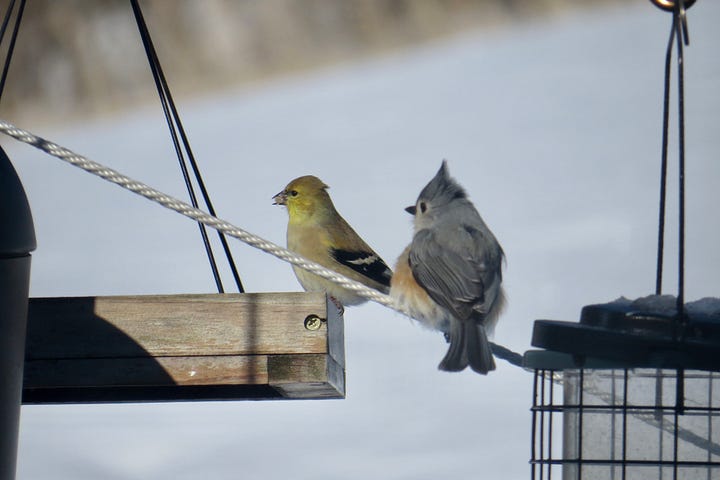
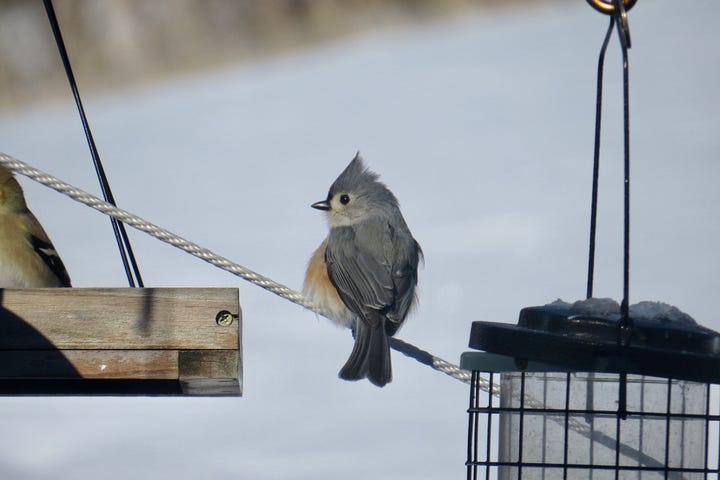
You'll also realize then, when you're watching them in your own backyard, different birds like different seeds. And there are some birds will never go to your feeder. Like you're not going to get [American] Robin sitting on your feeder. They're ground feeders. They're going to be looking for grubs in your grass.
When you get interested, then you want to put the plants in your yard that are going to attract birds that either will attract them because of the grubs and things, or it will attract them because of the nectar, if it's a hummingbird, or it'll attract them because of flowers that they're going to like or seeds that they're going to have. Some birds are just seed eaters, some are fruit and seed eaters. Some of them will change as the winter comes along. They'll have to switch over to seed. Most birds only eat insects when they're feeding their young. And so insect population is really critical to conserving birds, actually. So if you avoid spraying things like Roundup in your yard that are going to kill the insects. Because you won't get birds if there are no insects. You're not going to get birds in the summer, because they've got to feed their young and their young will just die because there's no insects. And we all know that we used to have our windshields would be covered in insects as we drove 20 years ago. They're not anymore. We don't have that problem anymore. There aren't as many insects around.
MF: And that could relate to birds population decreases.
MS: Absolutely. There'd be fewer birds. But you can help. You know, you can also put up bird boxes for bluebirds or for tree swallows or house sparrows. I mean, there's all sorts of things that you can put up. But providing places that they'll nest. We don't have as many fence posts and things that bluebirds might have nested in once. Now we need to provide bird boxes for them.
Don't get rid of all the dead trees that fall down in your yard because there's a lot of grubs and there's a lot of insects in those dead trees. They'll feed. It'll be a habitat for them. Getting rid of brush at the end of the fall is not great for birds. A lot of animals and insects will actually hibernate in that brush and there'll be food for when the new ones come back, when the birds come migrate back in the spring. So, you know, don't always clear up your yard. That's probably not what gardeners like to hear. But not cleaning up your yard will really help bird populations.
MF: Woodpeckers are often on the dead tree on the ground.
MS: They love dead trees on the ground. And you know, if you've got a brush pile, you'll find it full of white throated sparrows and dark eyed juncos. So yeah, there's a lot of things that you can have in your yard that will actually attract birds. So that's a good way to get started.
MF: It's really nice to be able to support wildlife right at your own house.
MS: Yeah. And I think people need to be more observant as they're walking around. I'm always amazed how, you know, I'll be walking along one of, say the Harland Valley rail trail, and someone will say, “so what have you seen?” And you'll say, “we've seen probably about 30 different species.” And they'll go, “really? That many?” They've maybe noticed two birds in their whole trail. So I think people have to be more cognizant, more aware when they're actually walking. What are they walking past, what are they actually seeing? But it's not that hard. In most backyards if you've got a bit of garden and you've got some plants and things, you probably can have the backyard species list easily of about 20 to 30 species in your backyard, even if you just have a very small backyard.
And you know, I probably have had over 100 species coming through my property at this point. But that's because I pay a lot of attention to what I'm seeing around, and I'm recognizing things that fly over, etc. But most people don't know they could have anywhere near that number of species. In the summer, in May, you know, probably just off the bird feeders and around the bird feeders, there could be easily 20, 25 different species around in the garden. And I think people need to be aware of that. People don't always notice what's right outside.
MF: And if they know there's this much wealth — if you don't know there's wealth, you have no way of protecting it either.
MS: That's right. I remember one of the first times I traveled to Florida, my friend down there had a dental hygienist who was a birder and she lived right in the middle of a subdivision in the middle of really, really busy concrete jungle of Florida, you know, built up. But she had completely turned her very, very small backyard over to birds. And she knew that at 4 o'clock the painted buntings would come flying into her yard and would be on her bird feeders. So, you know, quarter to four, we sit down on chairs in her backyard and sure enough, in come the painted buntings. She had a species list in her backyard of something like sort of 78 birds. 78 species in a little area in the middle of a completely built up area. But it was clearly she created this haven for birds flying through. There's all sorts of things you can do to actually create and really help with the conservation.
MF: That's really great.
MF: Is there anything you look forward in the coming months, bird wise?
MS: Yes, because the ducks will be coming back in much greater numbers in February once the water starts thawing. So you really need to get out on all the lakes. The river too, but the lakes as well. Don't forget the lakes and the ponds. And look and see what kind of different ducks there are out there. Different species of duck or grebe or loons. You might well see a common loon as they're starting to migrate north. We often have them on Copake Lake, for example. And then come April, there'll be the shorebirds that the little waders will start to come back. You'll start to maybe hear killdeer and maybe you'll start to hear and see solitary sandpipers, spotted sandpipers and things. They're passing through, they're going north. Most of the ducks that we see around here breed all the way up in northern Canada and up in the Arctic. So they've got to get there. And they'll be coming through in breeding plumage, usually, which is nice to see.
MF: You know, that's what I was a little confused about.
MS: Yeah. The breeding plumage is always different in different species. And even amongst ducks, it's not always the same.
MF: And the timing that they change to breeding plumage.
MS: Yeah. As we start seeing them in like February, March, they should be — more of them will be in breeding plumage.
MF: So we get to see them in their fanciest attire.
MS: Or at least in their transitional, on their way to the new attire. So if you start seeing wood ducks, right now they may be a bit drab, but you'll start seeing that transition. And then you'll start to see the real fancy wood duck. But they're south at the moment. They're probably in New Jersey having a good time, but we'll probably see wood duck in about another month.
MF: Okay, well, I look forward to that, too.
MS: Hopefully you and me both see them.
MF: Yes! Thank you.
Bird-inspired music of the month
A turkey track from Come Around to the Backdoor : Blues, Country, Jazz & Gospel from 1924, a compilation released by Tompkins Square on January 17, 2025, and field recording piece by Abby Lee Tee, released by Falt on January 21, 2025.






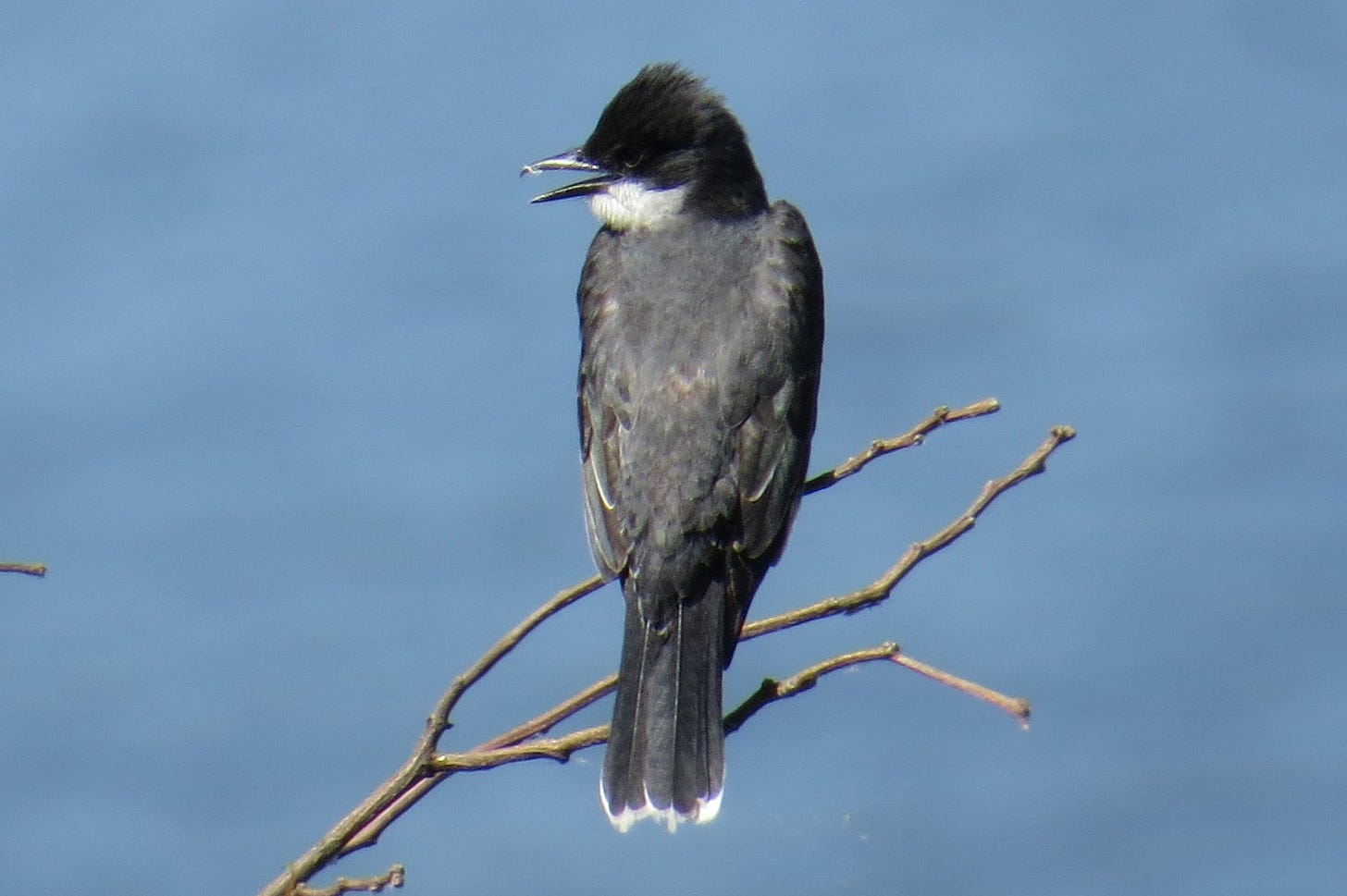

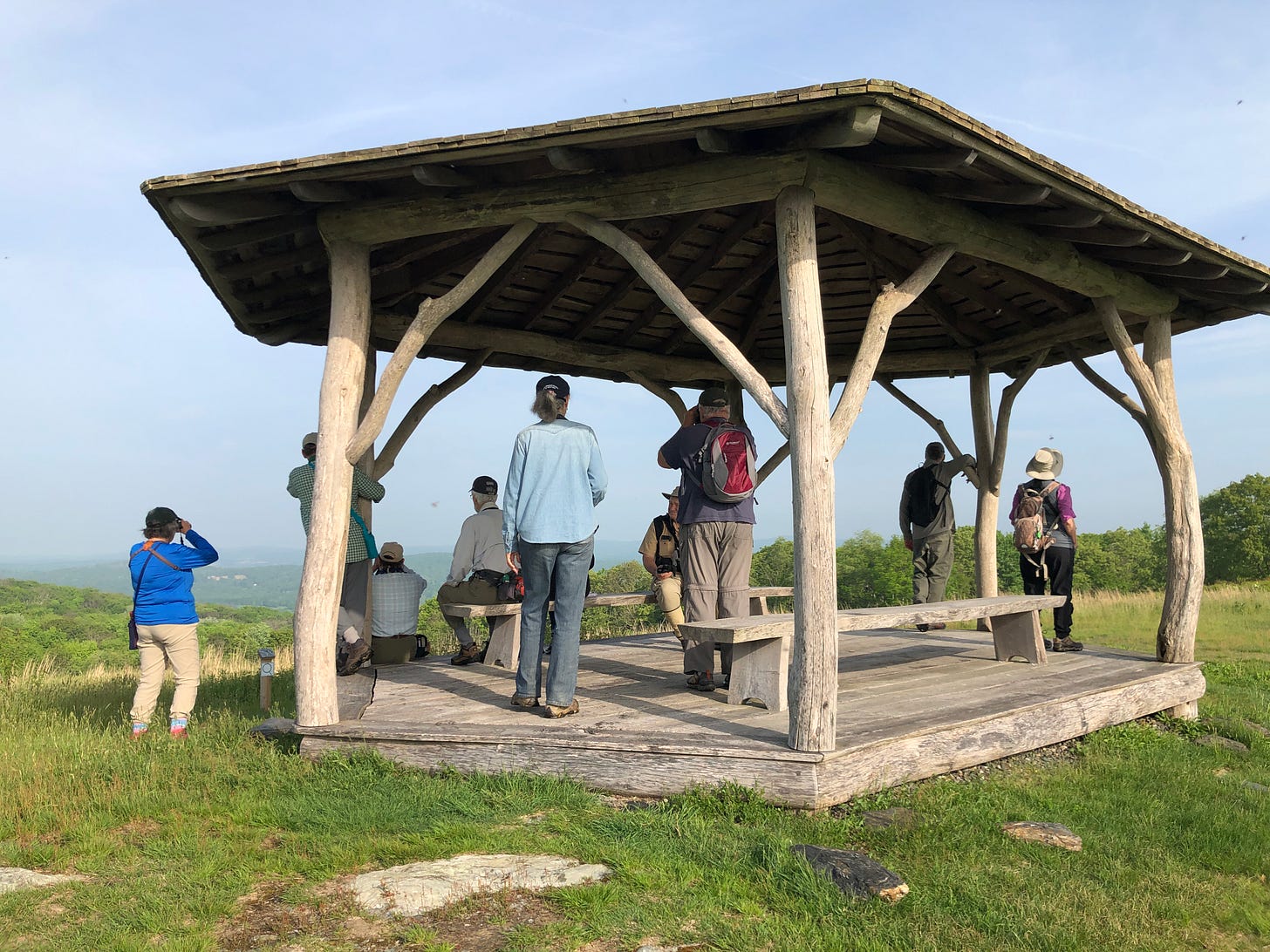

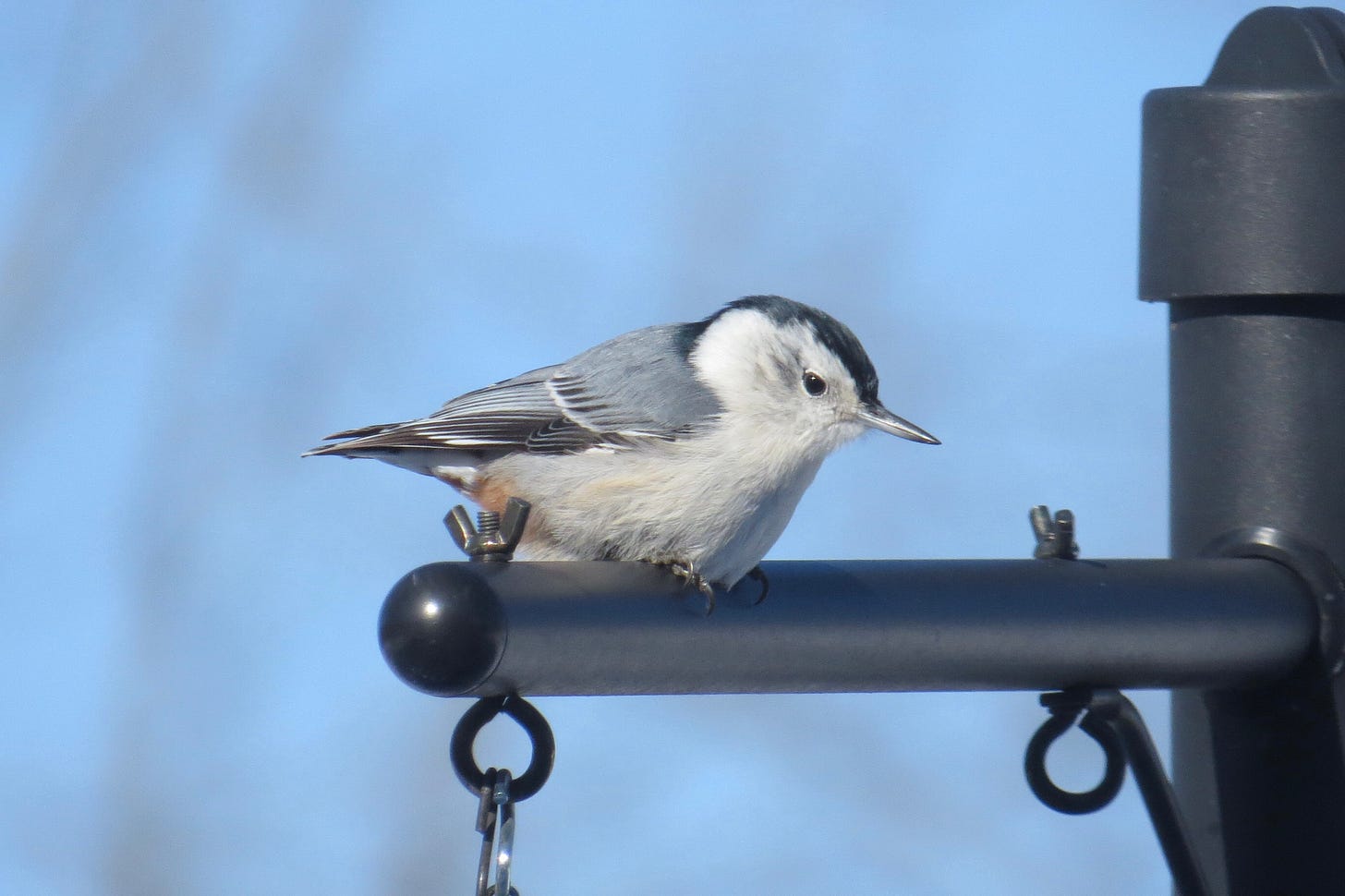
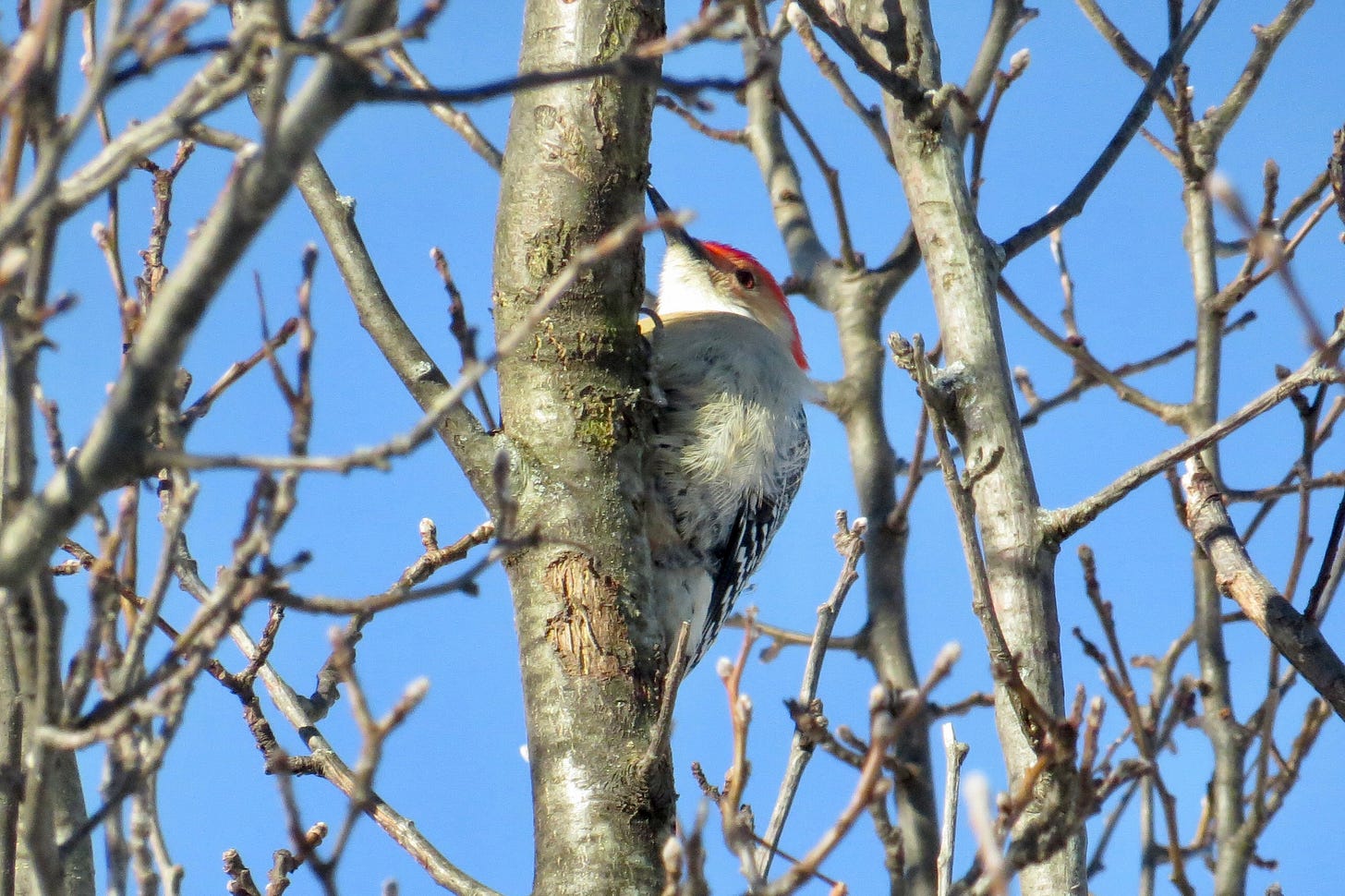
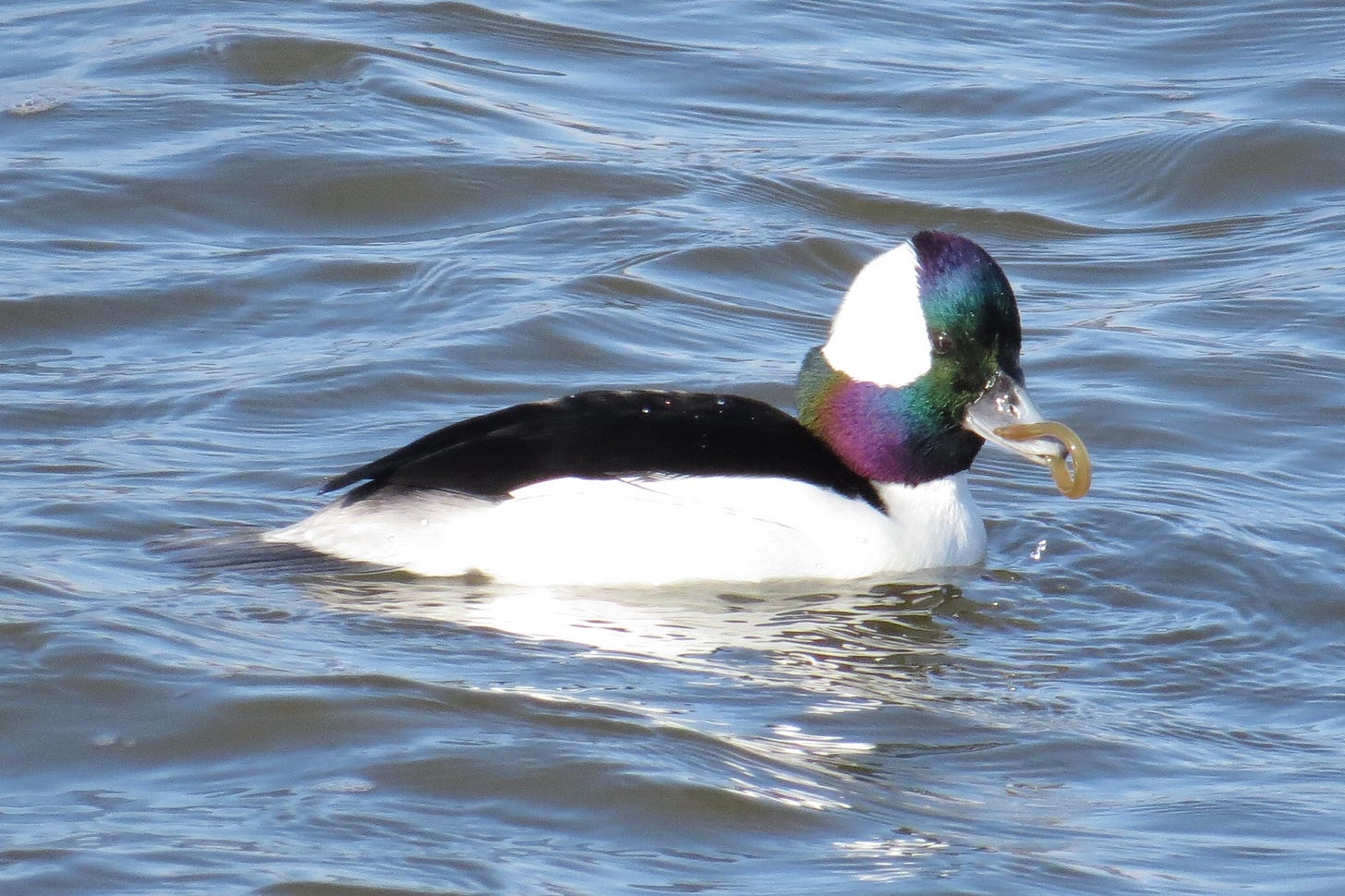





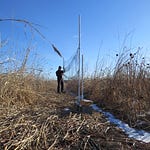


Share this post